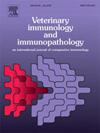高、中、低免疫应答荷斯坦奶牛和小母牛血液和初乳IgM和IgG B细胞谱
IF 1.4
3区 农林科学
Q4 IMMUNOLOGY
引用次数: 0
摘要
在奶牛中,更高的抗体介导(AMIR)和细胞介导(CMIR)免疫反应的遗传选择可以增强疾病抵抗力。牛产生一种独特的B细胞亚群,其B细胞受体具有超长互补决定区3 (CDR3)。具有这些特殊结构的抗体具有优越的病毒中和特性。已发表的关于奶牛B细胞受体具有超长CDR3s的研究受到了动物数量的限制(每次研究1-4只动物),以及品种和年龄的不同。本研究的目的是评估IgM和IgG序列具有超长CDR3s的百分比,以及基于其估计的育种值将奶牛的血液和初侧淋巴细胞分为高、平均和低免疫应答的基因使用情况。从14头小母牛和7头奶牛的血液中分离出B淋巴细胞。另外,从7头奶牛的初乳中分离细胞。提取RNA,生成cDNA,利用聚合酶链反应扩增IgM和IgG转录本。扩增子采用Oxford Nanopore长读测序法测序。在来自血液B细胞的序列中,AMIR估计的育种值与IgG超长CDR3序列的较高百分比显着正相关。高AMIR奶牛(n = 3)产的初乳中IgG超长CDR3序列的百分比(18.0 %)也显著高于平均AMIR奶牛(n = 4,平均8.8 %)。需要更大规模的研究来调查表达IgG超长CDR3s的B细胞百分比与观察到的健康特征之间的关系。本文章由计算机程序翻译,如有差异,请以英文原文为准。
Blood and colostral IgM and IgG B cell repertoires in high, average, and low immune responder Holstein Friesian cows and heifers
In dairy cattle, genetic selection for higher antibody-mediated (AMIR) and cell-mediated (CMIR) immune responses can enhance disease resistance. Cattle produce a unique subset of B cells with B cell receptors with ultralong complementarity determining regions 3 (CDR3). Antibodies with these specialized structures have superior virus neutralization characteristics. Published studies of B cell receptors with ultralong CDR3s in dairy cattle have been limited by the number of animals examined (1–4 animals in each study), and by varying breeds and ages. The objective of this study was to assess the percentage of IgM and IgG sequences with ultralong CDR3s, and gene usage in blood and colostral lymphocytes from cows classified as high, average, and low immune responders based on their estimated breeding values. B lymphocytes were isolated from the blood of 14 heifers and 7 cows. In addition, cells were isolated from colostrum of the 7 cows. RNA was extracted, cDNA was produced, and IgM and IgG transcripts were amplified using polymerase chain reactions. Amplicons were sequenced using Oxford Nanopore long-read sequencing. In sequences derived from blood B cells, AMIR estimated breeding values were significantly and positively associated with higher percentages of IgG ultralong CDR3 sequences. High AMIR cows (n = 3) also produced colostrum with a significantly greater percentage of IgG ultralong CDR3 sequences (18.0 %) than average AMIR cows (n = 4, mean 8.8 %). Larger studies are needed to investigate the association between percentages of B cells expressing IgG ultralong CDR3s and observed health traits.
求助全文
通过发布文献求助,成功后即可免费获取论文全文。
去求助
来源期刊
CiteScore
3.40
自引率
5.60%
发文量
79
审稿时长
70 days
期刊介绍:
The journal reports basic, comparative and clinical immunology as they pertain to the animal species designated here: livestock, poultry, and fish species that are major food animals and companion animals such as cats, dogs, horses and camels, and wildlife species that act as reservoirs for food, companion or human infectious diseases, or as models for human disease.
Rodent models of infectious diseases that are of importance in the animal species indicated above,when the disease requires a level of containment that is not readily available for larger animal experimentation (ABSL3), will be considered. Papers on rabbits, lizards, guinea pigs, badgers, armadillos, elephants, antelope, and buffalo will be reviewed if the research advances our fundamental understanding of immunology, or if they act as a reservoir of infectious disease for the primary animal species designated above, or for humans. Manuscripts employing other species will be reviewed if justified as fitting into the categories above.
The following topics are appropriate: biology of cells and mechanisms of the immune system, immunochemistry, immunodeficiencies, immunodiagnosis, immunogenetics, immunopathology, immunology of infectious disease and tumors, immunoprophylaxis including vaccine development and delivery, immunological aspects of pregnancy including passive immunity, autoimmuity, neuroimmunology, and transplanatation immunology. Manuscripts that describe new genes and development of tools such as monoclonal antibodies are also of interest when part of a larger biological study. Studies employing extracts or constituents (plant extracts, feed additives or microbiome) must be sufficiently defined to be reproduced in other laboratories and also provide evidence for possible mechanisms and not simply show an effect on the immune system.

 求助内容:
求助内容: 应助结果提醒方式:
应助结果提醒方式:


